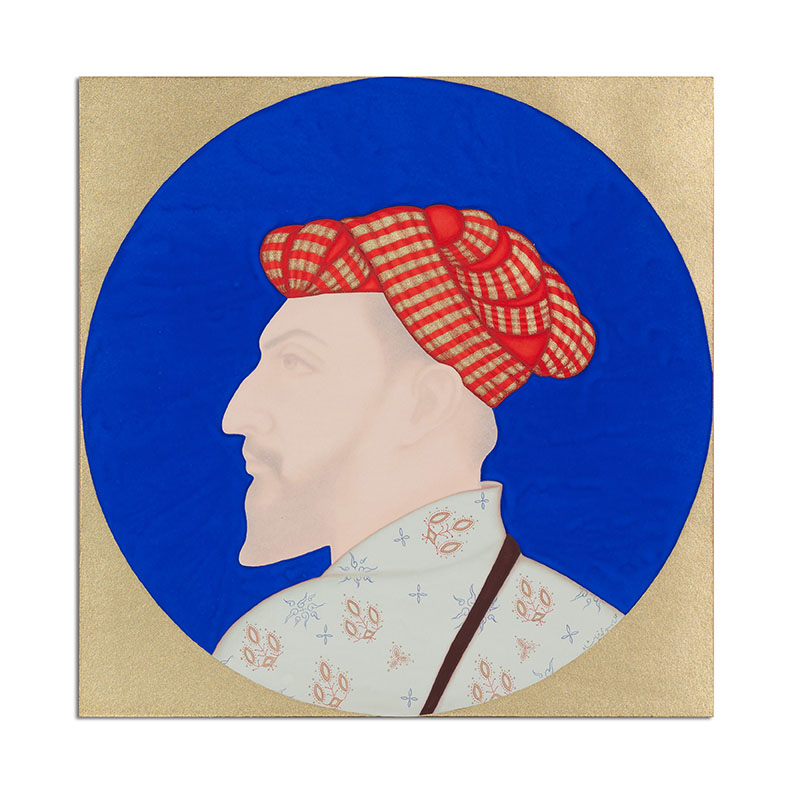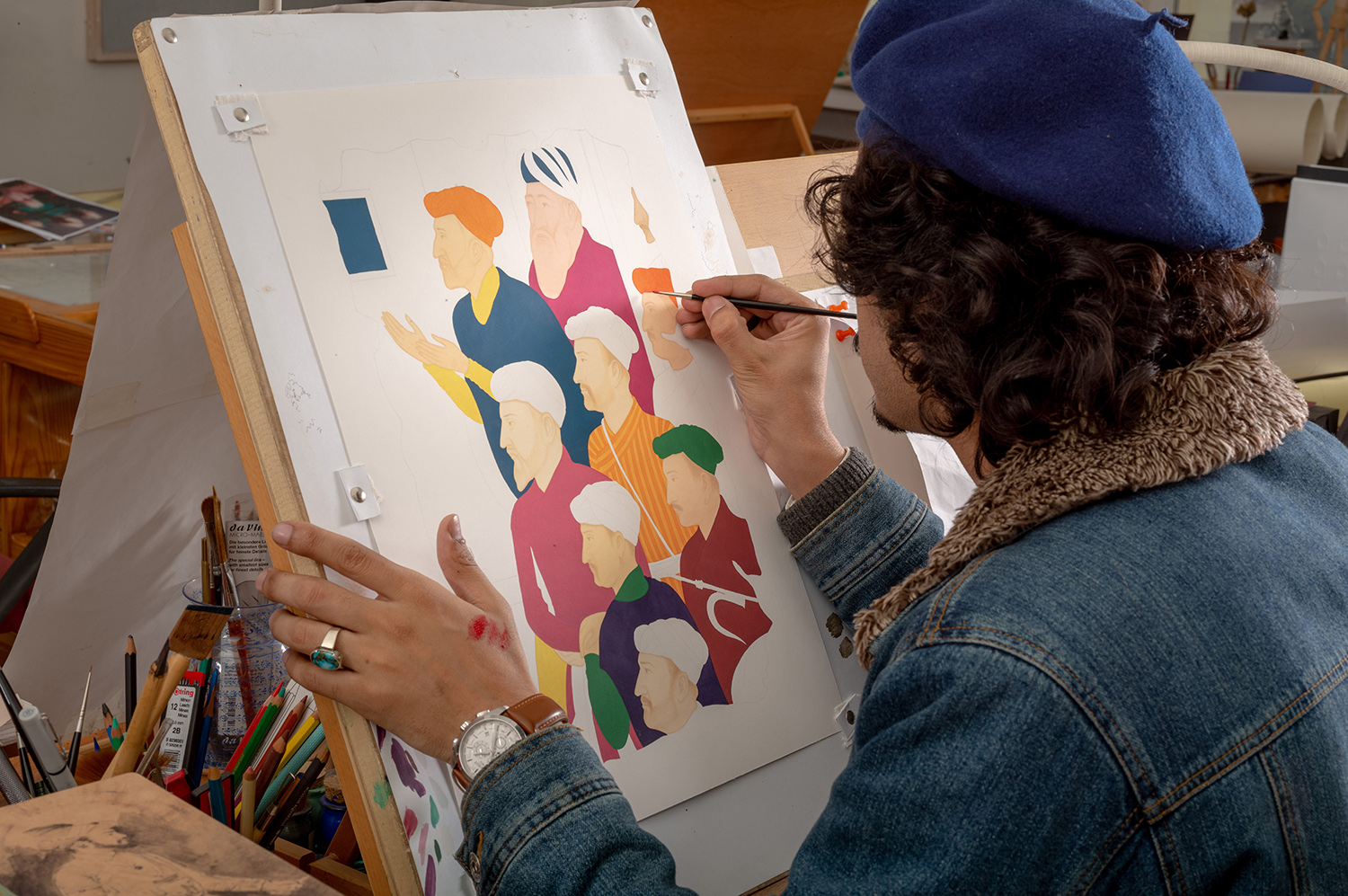Mughal history and natural pigments help contemporary miniature artist S. M. Khayyam create sensory explosions.
One should never change one’s approach to gain popularity. You will never do your best work if you do. One must avoid competition or gag oneself with how many shows you have gotten or how famous you have become. Internal authenticity is the key since you will never please everyone.

Shayista Khan. Contemporary miniature artist S. M. Khayyam.
Please tell us a little about yourself.
I am 28 years old. I belong to a Sufi family. My great grandfather migrated from Amritsar to Lahore. He was a Sufi saint and poet, known by name Baba Hussain Shah. My grandfather moved to Quetta from Lahore. My mother had an orthodox upbringing and, as I mentioned before, kept herself kept busy with embroidery and ceramics. I used to observe my father doing origami and making small wooden houses. He was one of my first teachers. I feel lucky that I had an artistic environment. I am passionate about art and music. I had an amazing mentor who encouraged me and presented me a world that captivated me further.
Tell us about your commitment to your current medium.
My artworks are done with natural pigments. Faded faces in my paintings accentuate the beautiful textiles of a bygone era. My miniature paintings are rich in freshly ground pigments. They are sensory explosions. Apart from painting kings, many of the people I painted vary in rank, like Shah Jahan’s nephew. Currently, I am working in natural watercolour.

Contemporary miniature artist S. M. Khayyam.
How do you describe yourself in the context of challenging people’s perspective via your art work?
Working as an artist has brought me into contact with an affluence of outlooks on the world and introduced me to a range of truly different perspectives, felt concepts, and knowledge.
In my work, I am interested in the passage of time and what remains. Our memories are based on our histories and experiences, which can dwell in either light or shadow. I explore the effects of time on memory, identity, and nature. In my work I looked at images from the historical point of view of Mughal’s, showcasing their memories. I paint them to keep their memory alive. One of my great challenges is how my artwork could distinctly impact people. My goal is to evoke and deliver perspectives and raise challenging, polygonal questions, rather than a single-minded one, as we live in a diverse culture. As a viewer, it changes their perspectives, opening mind and enhancing their experience. In my art and other forms of expressions, disagreement is accepted. I learn to explore spiritedly without a perceived plan and to embrace the opportunity to learn from mistakes.

Contemporary miniature artist S. M. Khayyam.
How do you deal with the conceptual difficulty and uncertainty of creating new work?
Whenever I am about to start any conceptual work, I plan beforehand, and then the execution happens. I brainstorm a lot. My conceptual work declares itself to be an art of the mind rather than the senses and, sometimes, it rejects traditional artistic aspects because it traces the artwork at the level of ideas rather than that of objects. My work is a process of thinking, making any activity or thought a work of art. Concept is the most important aspect of my work. I never think of the word “difficult” while making art. But sometimes difficulty in making conceptual art has to do with classifying the object of inspection.

Contemporary miniature artist S. M. Khayyam. Artist in studio.
Let’s talk about the evolution of your practice over the years. Tell us about your commitment to your current medium.
I believe that a practice is a continuous process. It is a blend of personal qualities, creative imagination, skills, and perspicuity. My practice depends on exploration that seeks to inspect practice development through concept perusal. My practice focusses on achieving cultural changes and helping it flourish.
I started practicing when I was a kid. My first work was embroidery, which I saw my mother do. I make sketches or patterns on cloth and then fill it with different colourful threads. I choose materials because of their unique qualities. I was aware of materials like adhesives and natural pigments because I worked with my father and he used natural materials or herbs for medicines. I used to observe his work and practice on natural pigments a lot. I love the process of making natural pigments from different stones. I was even anxious about how soon I could use them on paper or something else.
Nowadays, I work on natural pigments. I think that I am always on practice mode and learn to mentally picture that which cannot be directly observed. Then I imagine the possible ways a piece can be made.

Contemporary miniature artist S. M. Khayyam.
How does your audience interact and react to your work? Which shows, performances and experiences have shaped your own creative process? Who are your maestros? Whose journey you want to read about?
I think points of view are dependent on where a viewer is stationed in relation to everything else they see in my work. From my standpoint, art can have an impact on people in individual ways. Some of my paintings deliver a dichotomous experience. On one hand they give the viewer the impression that they are unfinished and on the other the same image doubles as a representation of decay, with fraying edges. Sometimes a viewer reacts both positively and negatively. I think a viewer has the right to think as she or he wants.
Whenever I look at other artists’ work I realise that a lot of the work can’t be done by just signing up for a workshop or an art class once a week. Nor can you expect gallery representation and collectors to follow thereafter. Most successful artists have natural talent, a long history of education and a lot of practice under their belt. My goal is to be the best artist I am capable of being. It is not about fame or money. If that means earning your living from a day job, that’s perfectly okay.
I used to go for art shows and performances a lot and it has had a great impact on my life and creative skills. Natural talent is not as ubiquitous as one thinks. It takes great effort and practice to get to the point where it feels as if natural talent is at work.
I really get inspired by Leonardo da Vinci when I read and study about him and his skills. He was a true genius. I really like each discipline informing his mastery of the others. I loved that da Vinci probably progressed from doing various menial tasks around the studio to mixing paints and preparing surfaces.
I also like Anselm Kiefer, David Hockney, Anish Kapoor, Damien Hirst, and Vija Celmins.

Khan Dawran. Contemporary miniature artist S. M. Khayyam.
What was your first sale? Do you handle the commercials yourself or is it outsourced to a gallery or an agent?
I did my first commissioned work when I was a student. I used to go to the studio to learn art skills from an amazing instructor, Sir Mehmood Rishi. Once a person came to Mehmood sir’s studio for a commissioned work and he recommended me. I made a pencil portrait and got 300 hundred Pakistani rupees.
What is the best piece of advice you have received? Why was it helpful?
After my intermediate levels I went to Mehmood sir’s studio in Quetta, Baluchistan, to improve my skills. He was an amazing person inside and out. He used to advise me a lot. I remember something he said about my field of work. He told me to paint only that which inspires and interests me and told me to paint the way I choose to do it. He added that one should never change one’s approach to gain popularity. You will never do your best work if you do. One must avoid competition or gag oneself with how many shows you have gotten or how famous you have become. Internal authenticity is the key since you will never please everyone. This piece of advice was really helpful. It gave me the strength to do my work with intent.

Contemporary miniature artist S. M. Khayyam.
Tell us about your studio. What kind of a place is it? Could you describe your usual workday in the studio?
It’s basically an apartment and a workplace for teaching and practicing art. The apartment consists of a room and a hall, which function as the kitchen, living room and bedroom.
Are you more of a studio artist or naturally collaborative by nature? How do you feel about commissions?
By nature I am a studio artist. In my career, I haven’t had many commissions but enough to provide a range of experiences. I have worked on commissions that were difficult for various reasons, some were like impositions on my time, and others were satisfying but took many weeks to finish and involved challenging logistics. Then there have been a few that were straightforward, satisfying, and positive experiences all throughout.
Some artists actively seek commissions and rely on them for income, but my views about them are mixed. My feelings about commissions depend on individual goals and just how comfortable I am about making art on demand. I think the demand for art is not great enough to support all of the talented artists who need to earn a living.

Contemporary miniature artist S. M. Khayyam.
What are you working on new? What’s coming next season?
I am exploring something really new. I am devoted because something exciting is going to happen. It is a radically new realm, and that will be obvious to others.
Before you go – you might like to browse our Artist Interviews. Interviews of artists and outliers on how to be an artist. Contemporary artists on the source of their creative inspiration.c











Add Comment